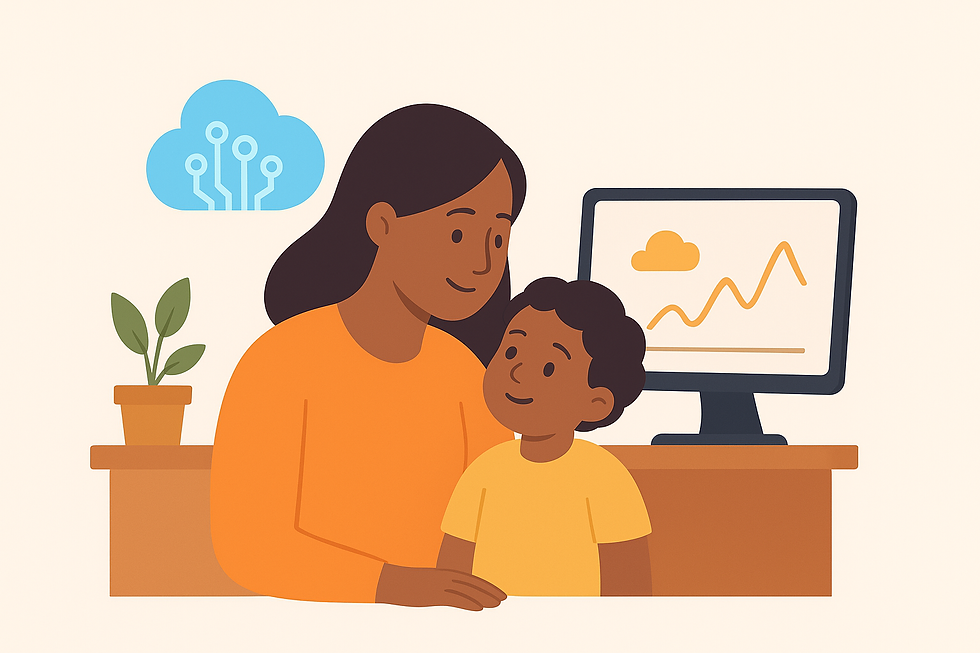The Dual Perspective on AI
- nicolebruehl
- Aug 26
- 4 min read

Written by Darwish Thajudeen
Artificial intelligence has become one of the most polarizing topics in media coverage today (1) (2) (3) (6). On one hand, AI is framed as a displacement engine—a system that automates jobs, undermines creative labor, and replaces human expertise with faster, cheaper machine outputs (4) (5). On the other hand, it is celebrated as a force of multiplication—a tool that amplifies human potential, accelerates complex tasks, and enables breakthroughs that would otherwise take decades .
Interestingly, these narratives are not confined to different professions or industries. They exist within the same communities, particularly among artists and scientists, who simultaneously view AI as both a threat and a collaborator (6).
Creativity in Conflict: Artists vs. Algorithms
In the arts, AI’s ability to generate content at scale has sparked deep unease. Illustrators see AI image generators flooding online platforms with work that mimics human styles. Photographers worry that AI-enhanced visuals diminish the value of carefully crafted imagery. Video editors question the future of their role when machines can splice and enhance footage with minimal oversight. For many, AI represents an undervaluing of human creativity—reducing artistry to a set of predictable prompts (7) (8).
Yet the same technology inspires optimism among other creators. Consider automotive designers, who once spent weeks hand-sketching variations of a car concept. Today, AI tools allow them to produce hundreds of mockups in a matter of hours, sparking new directions that might have been overlooked. In fashion, concept designers use AI to experiment with patterns, textures, and silhouettes at speeds impossible for traditional methods. For these artists, AI is less a competitor than a creative accelerator, expanding imagination rather than constraining it (9) (10).
The Scientist’s Paradox: Automation vs. Expansion
The scientific community finds itself in a parallel dilemma. Programmers, for instance, recognize the power of AI systems that can write clean code, debug errors, and optimize performance (11) (12). While this improves efficiency, it also raises concerns: if machines can handle routine programming, what happens to junior developers just entering the field? Will automation narrow opportunities for human growth, or free engineers to focus on higher-level innovation (13) (14) (15)?
But once again, optimism runs alongside concern. In fields like drug discovery, AI is not eliminating scientists but augmenting them. Traditional pharmaceutical research requires years of trial and error to identify viable compounds. AI can now analyze millions of molecular structures in weeks, surfacing promising candidates for human review. Far from replacement, this is a multiplier effect—where scientists remain the decision-makers, but AI dramatically reduces the time between discovery and application (16) (17).
Why the Divide Exists
The contrasting narratives stem from how people frame the relationship between AI and human expertise. When AI is seen as an imitation—reproducing artworks, code, or texts that humans once produced—the reaction skews toward fear of replacement. When it is viewed as an augmentation—handling repetitive tasks or surfacing possibilities humans alone could not manage—the perception shifts toward opportunity.
This divide also reflects broader economic and cultural dynamics. In creative fields, originality and identity are central, so AI’s ability to mimic style feels like an existential challenge (18). In science, progress is measured by efficiency and discovery, so AI’s acceleration is often welcomed, because it amplifies the efforts, with even a novel coined term called intelligence amplification (19). The same tool, then, is interpreted through entirely different lenses depending on what the field values most.
Beyond Fear and Hype
The danger lies in treating AI as either an all-encompassing threat or a flawless savior (20). History shows that disruptive technologies almost always produce both displacement and expansion. The printing press undermined scribes but democratized knowledge. Industrial machinery replaced manual labor but spurred new industries. In each case, society had to negotiate the balance between loss and progress.
AI is no different. It will undoubtedly automate certain tasks, especially those that can be standardized or scaled. But it will also create new opportunities—roles that center around supervision, orchestration, and creativity at scale. The question is not whether AI replaces or empowers, but how professionals, institutions, and policymakers choose to shape its adoption.
Writing the Future Together
What unites both artists and scientists is a shared agency: the power to decide whether AI becomes a rival or an ally. Artists can use AI as a tool to explore new forms, or resist it as an intruder in their creative space. Scientists can harness AI to accelerate discovery, or fear its encroachment on traditional expertise.
The truth is that AI does not write the narrative on its own—we do. The displacement and multiplication perspectives will continue to coexist, reflecting not just the capacity of machines but the values of the humans who adopt them.
The story of AI is less about what it does, and more about how we choose to frame it. And here at MI4People, we choose to take the good aspects of AI and make it work for the greater good of the community. We make use of this technology to create meaningful and impactful solutions that last for decades to come and save time and lives now. You could learn more about such projects of on our LinkedIn, Website and other social media pages. Check them out and support us. If you are also interested in joining this movement please reach out to us, and we are always happy to welcome more and more helping hands on deck.
With heartfelt gratitude,
MI4People Team



Comments